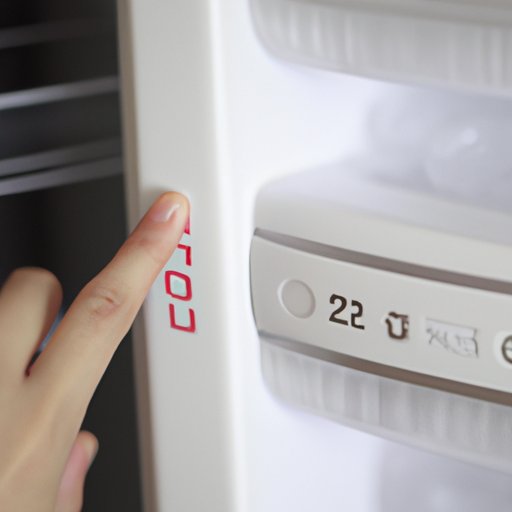Introduction
When it comes to food storage, one of the most important factors is maintaining the correct temperature. A refrigerator is designed to keep food at a safe and consistent temperature, but what is the ideal temperature range? This article will provide an overview of refrigerator temperature and discuss the importance of setting the right temperature.
How to Determine the Ideal Temperature for Your Refrigerator
The optimal temperature range for a refrigerator is between 35°F and 40°F (1.7°C and 4.4°C). Anything lower than 35°F can cause food to freeze, and anything higher than 40°F can cause spoilage. To ensure that your refrigerator is set to the right temperature, you should check the internal temperature with an appliance thermometer.
Tips for Setting the Right Temperature
Once you have determined the ideal temperature range for your refrigerator, you should adjust the temperature accordingly. Here are some tips for setting the right temperature:
- Adjust the temperature gradually. Don’t make sudden changes or your food may spoil.
- Check the temperature regularly. Make sure that the temperature is still in the optimal range.
- Be aware of how often you open and close the door. The more often you open the door, the more likely it is that the temperature will fluctuate.
- Place a thermometer inside the fridge. This will help you monitor the temperature and make adjustments as needed.
What Temperature Should You Set Your Refrigerator At?
The ideal temperature for your refrigerator is between 35°F and 40°F (1.7°C and 4.4°C). Keeping your refrigerator at this temperature range will help maintain the quality of your food and prevent spoilage. Additionally, it will help reduce the risk of foodborne illness.

The Benefits of Keeping Your Refrigerator at the Right Temperature
Maintaining the correct temperature in your refrigerator is essential for preserving the quality of your food. When food is stored at the right temperature, it will stay fresh longer and be less likely to spoil. Additionally, keeping your refrigerator at the right temperature will help reduce the risk of foodborne illnesses, such as salmonella and E. coli.
Does the Temperature of Your Refrigerator Affect Food Safety?
Yes, the temperature of your refrigerator can have a significant impact on food safety. If the temperature is too low, food can freeze and become inedible. If the temperature is too high, bacteria can grow and contaminate food, leading to foodborne illness. Therefore, it is important to make sure that your refrigerator is set to the correct temperature to ensure that food remains safe to eat.

A Guide to Adjusting the Temperature of Your Fridge
If you need to adjust the temperature of your refrigerator, here are some proven strategies for maintaining the perfect temperature:
- Check the temperature regularly. Check the temperature with a thermometer at least once a week to make sure it is still in the optimal range.
- Keep the door closed. Opening and closing the door too often can cause the temperature to fluctuate.
- Organize your food. Group together items that require the same temperature and store them in separate compartments.
- Clean the coils. Dirty coils can cause the refrigerator to work harder and not maintain the desired temperature.
- Check for air leaks. Inspect the door seals for cracks or gaps and replace any worn or damaged parts.

Considerations for Different Types of Food
Different types of food require different temperatures in order to remain safe and fresh. For example, eggs should be kept at a temperature below 40°F (4.4°C) to prevent the growth of bacteria. Fresh produce should also be stored at a temperature below 40°F (4.4°C) to prevent spoilage. Milk, cheese, and other dairy products should be stored between 35°F and 38°F (1.7°C and 3.3°C). Finally, meats and seafood should be stored at a temperature of 32°F to 34°F (0°C to 1.1°C).
Conclusion
In conclusion, the ideal temperature for a refrigerator is between 35°F and 40°F (1.7°C and 4.4°C). Keeping your refrigerator at this temperature range will help maintain the quality of your food and reduce the risk of foodborne illness. Additionally, there are several strategies for adjusting the temperature of your refrigerator, such as checking the temperature regularly and keeping the door closed. Finally, different types of food require different temperatures in order to remain safe and fresh.
Summary of Key Points
To recap, the optimal temperature range for a refrigerator is between 35°F and 40°F (1.7°C and 4.4°C). You should use an appliance thermometer to check the internal temperature of your refrigerator and make any necessary adjustments. There are several strategies for adjusting the temperature of your refrigerator, such as checking the temperature regularly and keeping the door closed. Additionally, different types of food require different temperatures in order to remain safe and fresh.
Final Thoughts
Maintaining the correct temperature in your refrigerator is essential for preserving the quality of your food and preventing foodborne illnesses. By following the tips outlined in this article, you can ensure that your refrigerator is set to the right temperature and that your food remains safe to eat.


